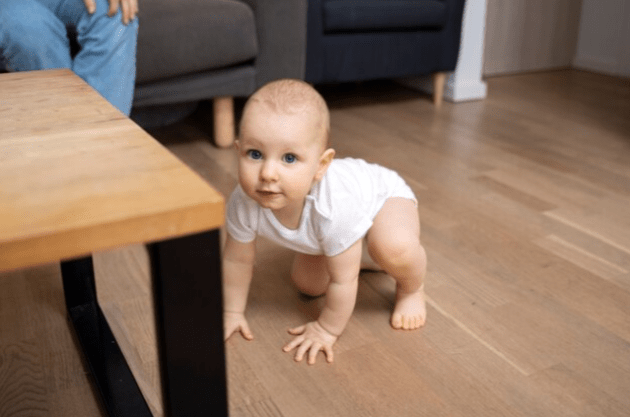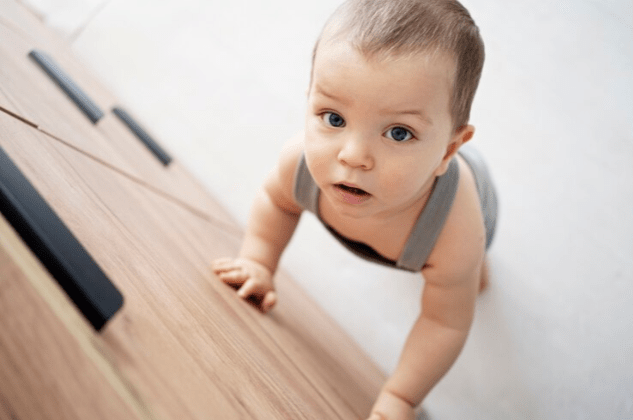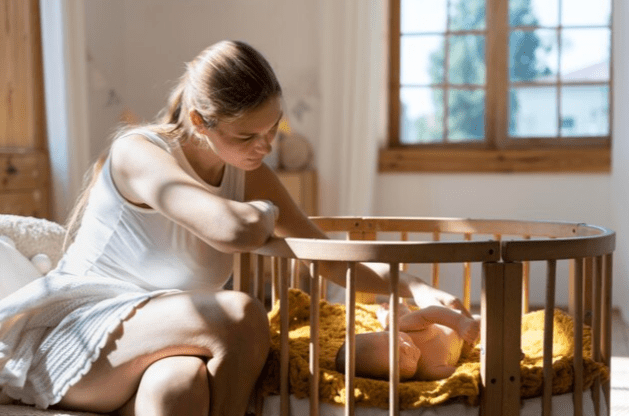Your tiny babe who’s wrapped like a burrito is going to be an eager crawler or cruiser ready to explore before you know it. And one thing is for certain: you have to start infant proofing your home (and fast — especially if your infant is already an accomplished crawler).
Tackling the entire house may seem daunting, but it’s manageable if you break it down room by room. Baby gates are your number-one concern since blocking access to a space is the best way to keep your busy crawler from harm. Clearing the decks is next. Remove and put away anything hazardous (plants, hard candy) or breakable, like picture frames and glass bowls.
And remember, no matter how much you infant proofing a home, there’s no substitute for your eagle-eyed supervision — kids can be surprisingly creative when it comes to getting into mischief.
For more help, here’s how to infant proofing every room in the house so your sweetie stays safe.
Infant proofing the house

Infant proofing the house in general is about making sure you have the safety essentials installed and your home’s repairs and renovations are up to date.
Carbon monoxide and smoke detectors
Both of these devices are critical. Make certain to test yours about once a month so you know they’re either fully charged or the batteries inside are fresh. Change batteries annually (or when the devices indicate that a new battery is needed). Experts recommend timing the switch with something like changing the clocks back in the fall or forward in the spring for Daylight Saving Time.
First aid kit
Not only should you and other caregivers be trained in infant CPR, but having a well-stocked first aid kit on hand (with supplies including bandages, alcohol wipes, antibiotic ointment and pain medications) is also important.
Living Room: What’s Right
You might be surprised to learn about the dangers hidden in plain sight when it comes to infant proofing your living room. See if you can spot what is right in this image and then read on to learn more.
Candles and matches are out of reach
It’s possible for a toddler to accidentally light a match and start a fire, no matter how undeveloped their fine motor skills are. And if your baby chews on a candle, they could choke on the wax. Keep candles and matches well out of reach, and consider trying flameless LED candles to mimic the effect of flickering candlelight.
Photo frames are up and away
If your child knocks over or drops a frame, the glass can shatter and cut him, even in a carpeted room. Put frames somewhere well out of reach, mount them on the wall, or replace them with plastic.
TV is mounted
If a child tries to climb on a TV stand, the set can fall on them. Mount your television securely on the wall, if possible. TVs on stands need to be anchored to the wall, too: Slip industrial-strength Velcro straps through the air-vent holes and connect them to eye hooks that you screw into the wall.
Fireplace is covered
Install heat-resistant gates to use while the flames are burning. Kids could fall and injure themselves against a sharp or stony hearth, so make sure you buy pads for the edges. Artificial fireplaces often contain small rocks that are a choking hazard—if yours does, remove them. Two risks in our picture: The doors should be locked when not in use, and the fire-stoking tools should be out of reach.
Living Room: What’s Wrong
Did you spot all the instances of safety done right in the image above? Now look again and see if you can spot what’s wrong, then read on to learn more about live room safety.
Power strip is exposed
Your child could easily unplug a cord from the power strip, stick a metal object inside one of the holes, and electrocute himself. Keep power strips hidden behind furniture or buy a power-strip cover if they must be exposed.
Small toys are everywhere
Round, cylindrical, or oval objects smaller than 1 inch in diameter can completely block a young child’s throat and cause fatal choking. (And little square toys can be a risk too.) So these should not be used by children, probably until they are 5 years old, says Parents advisor Gary Smith, M.D., Dr. P.H., director of the Center for Injury Research and Policy at Nationwide Children’s Hospital in Columbus, Ohio.
Remote control has a missing battery cover
Be especially careful of button batteries—the kind you find in watches, hearing aids, greeting cards, and some toys—which are higher voltage than traditional batteries. If your child swallows any type of battery, it can get lodged in the esophagus and cause severe damage, so get him to the E.R. immediately.
Glass coffee table is unprotected
Table edges are treacherous for a little kid learning to walk. “Your toddler can badly cut her forehead and eye area,” says UAB study coauthor and clinical psychologist David Schwebel, Ph.D., an expert in unintentional-injury prevention. Call the manufacturer to find out what kind of glass your table is made of. If it’s non-tempered, which shatters easily, put it in a room your toddler can’t access—or buy a new tempered-glass top and edge guards.
Bedroom: What’s Right
You might not spend a lot of time in your bedroom during the day, but it is still a place to be concerned about safety. See if you can spot the infant proofing done right in the picture above and then read on to learn more.
Crib is set up safely
Once your child can sit up, it’s time to lower the crib mattress. Be careful with stuffed animals, too—they’re a suffocation risk for babies, and they can make an easy step stool for a little one who wants to get out. Traditional drop-side cribs are now banned from being sold in the United States; if the drop-side breaks, a child can become trapped between the crib and the mattress and suffocate, according to the U.S. Consumer Product Safety Commission (CPSC). If your crib has a drop side, the CPSC recommends replacing it with a fixed-side crib or, at the very least, checking on CPSC to see if it has been recalled.
Window has a guard
Windows should only be able to open 3 inches, about the height of an adult fist, or they should have a window guard. “And if you have a window that’s low to the floor, or a window seat, it’s imperative that you install a guard,” says safety expert Alison Rhodes-Jacobson of Wilton, Connecticut, who founded the childproofing company Safety Mom Solutions. For casement windows, Rhodes recommends removing the crank and keeping it somewhere that you can easily access.
Window blinds are cordless
A child can get their neck caught in a looped cord and be strangled. More than 200 young children have died this way since 1990, according to the CPSC. Eliminate the hazard by cutting the loop and adding free tassels from windowcoverings.org. But if possible, invest in new cordless window coverings.
Bedroom: What’s Wrong
Did you spot everything done correctly in that image? Now try and see if you can spot what was wrong then read check out these safety tips.
Balloon is within reach
“Latex balloons should be kept completely away from children under 8,” says Dr. Smith. “As many as half of children’s choking deaths caused by toys are due to balloons.” If a child puts a popped balloon in their mouth, the balloon can drape itself over the entrance to their larynx, covering it like shrink-wrap, and suffocating them, he explains.
Crayons are left out
Even little hands can snap a crayon in two so it’s small enough to choke on. Always supervise your child using art supplies, and consider getting chubby round crayons like Crayola Tadoodles.
Dresser isn’t secure
According to Nationwide Children’s Hospital, 11,521 kids visit the E.R. for tip-over-related injuries every year—that’s one child every 46 minutes. “All heavy furniture needs to be anchored to the wall or to the floor,” says Dr. Smith.
Porcelain piggy bank isn’t up high enough
A child could easily climb up those “stairs” of dresser drawers and grab the bank. And once a child does, the bank could shatter, and they could get cut by the broken pieces or choke on the coins inside. Because coins are the perfect size and shape to block your child’s airway, experts recommend keeping them away from toddlers entirely. (This goes for plastic ones too.) You can also install drawer stops that keep drawers from being open more than two-thirds of the way.
Kitchen: What’s Right
You probably guessed that the kitchen is one of the most dangerous zones in your home. But don’t worry; we’ll show you how to keep it safe from accidents.
Kitchen is gated
Because the room is full of risks, it’s a good idea to make it off-limits when you’re not around.
Lower cabinets are protected
Cleaning products like drain openers, automatic dishwasher detergents, and furniture polish are toxic. Either secure the cabinet with a magnetic lock, use a traditional latch along with a infant proofing locked box, or place chemicals high up, well out of reach, recommends Jim Schmidt, M.D., a pediatric emergency-room physician and cofounder of Child Safety Housecalls, a childproofing and safety company in Virginia Beach, Virginia.
Dishwasher is locked
The biggest hazard is ingesting the detergent, says Dr. Schmidt. Make a point of running the dishwasher as soon as you add the detergent. Store knives with blades down and leave dishes in the machine for as short a time as possible. Many dishwashers have a lock setting, so check yours. Otherwise, consider an appliance lock—you may have to try a few to find one that works well with your machine.
Microwave is out of reach
Mounting it up high is best, but if yours must sit on the counter and your child’s present, don’t turn it on and walk away, never leave hot food in it, and make sure your child’s not around when you take hot food or liquids out.
Stove knobs are removed
Pull them off when you’re not cooking. Even better, use a stove guard—a plastic or metal shield that attaches to the front—which makes it harder for curious hands to reach burners. Dr. Schmidt prefers a guard to knob covers, which don’t fit all stoves and can be inconvenient to use. Be sure to cook on the back burners whenever possible, and never let pan handles face forward.
Kitchen: What’s wrong

Take another look at the kitchen picture and see if you can spot what’s wrong. Did you get them all right? Read on for more kitchen safety tips.
Oven is easy to open
The most significant risk here is burns, but your child could also hit their head with the oven door if you leave a dish towel hanging from the handle and they pull on it. If your oven has settings, check to see whether one lets you lock the door. Otherwise, the safest thing to do is install an oven latch or put a baby gate across the entrance to the kitchen.
Small appliances are accessible
The average height of a typical American kitchen counter is 36 inches, and the average height of a toddler is around 32 inches, which means that most toddlers can reach onto a kitchen countertop, That ability to reach can spell disaster since they are tall enough to turn over appliances and other heavy and dangerous items. Even if your coffeemaker is set toward the counter’s rear, ensure the cords aren’t sticking out. And don’t leave a stool out since toddlers can use it to get to off-limits areas.
Cutlery is reachable
As convenient as it is to keep a butcher block of knives sitting on the counter, that’s a mistake. Store it in an above-the-counter cabinet. This is crucial if you have a child with special needs, notes Rhodes: “They can be more likely to be impulsive and grab items that can pose a danger.”
Refrigerator isn’t secured
If your child can pull your fridge open on their own, consider installing a latch. And at the very least, make sure you’re aware of what’s in there, says Dr. Schmidt: Always keep choking hazards like grapes, breakables like wine bottles, and poisons such as medications out of reach on high shelves.
We hope you found this information helpful in your journey to create a safer environment for your family. At GuardWell Safety, we understand that every home is unique, and so are your child-proofing needs. That’s why we offer a Free Child-Proofing Consultation tailored to your specific requirements. Let our experts help you identify potential hazards and provide personalized solutions to make your home a secure haven for your little ones. Book your free consultation today and take the first step towards peace of mind.






